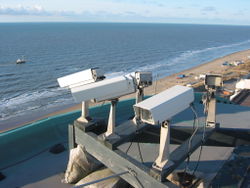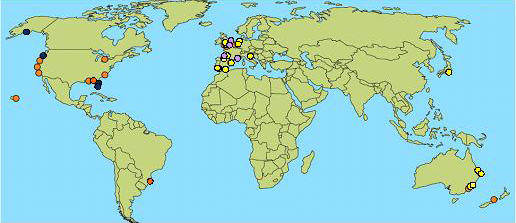Argus video monitoring system
This article provides an introduces the video monitoring Argus. The article explains why Argus has been developed, where it is used and how it works. Also a literature list is provided with an overview of literature about Argus.
Contents
Introduction
Until only a few years ago, all information on nearshore morphodynamics had to be gathered from comprehensive field experience. This form of data collection had some fundamental limitations. One problem was the fact that such experiments were relatively expensive and that there was only a limited amount of instrument positions in traditional field experiments. A synoptical pattern is thus difficult to get with the use of a traditional field set up, but this can easily be measured with a shore-based video system. Another and even more important characteristic was the fact that the observation time scale was in practice limited to several weeks. Finally, the ability to survey during times of severe weather and wave conditions was hardly possible. With the recent advent of new digital imaging technology, shore-based video systems provide the additional capability of automated data collection, encompassing a much greater range of time and spatial scales than were previously possible.
History and use of Argus
The history behind video imaging in near-shore studies dates back to the 1930s, where the first attempts to study coastal processes were made with the help of aerial photography (see also use of aerial photographs for shoreline position and mapping applications). In 1980, the Coastal Imaging Lab (CIL) at Oregon State University began early efforts in optical remote sensing (see also optical remote sensing) with the use of time-lapse movie measurements of wave runup as a diagnostic method of sampling infragravity edge waves (Holman, 1981). While the move from the traditionally in-situ sensors was largely dictated by the intimidating surf conditions of the U.S. Pacific Northwest, the logistics, cost and data benefits soon drove the lab to an all-optical approach to nearshore sampling. This was boosted enormously by the early discovery that ten-minute time-exposure (timex) images could be used to locate submerged sand bars and rip channels, a remarkable simplification over traditional surveying approaches (Lippmann and Holman, 1989[1]). The power of the timex technique led to the development in 1992 of automated unmanned stations called Argus Stations, programmed to collect these images hourly at any site of research interest.
Time exposure images have been the primary product of the Argus Program, revealing surprising nearshore morphologies and very dynamic behavior on nearly every beach sampled to date. For example, Lippmann and Holman (1990[2]) documents statistics of morphological states at the much-studied Duck Field Research Facility (FRF), showing that simple or rhythmic morphologies are rare, with the median system state being a complex pattern. The simplicity and robustness of image collection and the high information content of time exposure images has strongly supported the arguments for optical remote sensing as an important nearshore monitoring tool and has made the Argus Program very successful.
Being continuously improved since 1992, the so-called Argus system nowadays features fully digital video technology which provides high image quality in combination with detailed pixel resolution. Continuous (typically every daylight hour) collection of image data with a resolution of centimetres to meters, extending along regions of hundreds of meters to several kilometres, is now routinely undertaken at sites in the USA, Europe, Australia and Asia. Since the first automated Argus station was installed at Agate Beach on the Oregon Coast in 1992, the CIL-based program has expanded to 12 locations around the world. Sites were selected to span the parameter space considered relevant to nearshore processes research (ranges in wave period, wave height, tide range and beach slope). Approximately 30 Argus stations and 120 cameras are now operating daily in 8 countries (see also Figure 2). The greatest acceptance has been in Europe, where Argus technologies are at the heart of the three-year EU CoastView program, and in Australia, where 10 stations are now operating. These stations provide hourly measurements of a variety of topographic, geomorphological and fluid variables and are usually focused on practical Coastal Zone Management (CZM) issues.
The history of Argus in summary:
- 1980: Initiated by Coastal Imaging Lab, Oregon State University
- 1980-1990: Follow-up of initial video imaging studies in late eighties
- 1992: CIL-based program, installation of unmanned, automated video stations
- 1992: First installation in Yaquina Head, OR, USA
- 1995: First installation outside USA (Noordwijk, NL)
- 1999: First installation for CZM purposes (Egmond JvS, NL)
- Now: Presently over 30 Argus sites worldwide
Monitoring process
An Argus monitoring system typically consists of four to five video cameras, spanning a 180º view, and allowing full coverage of about four to six kilometres of beach. The cameras are mounted on an elevated position along the coast and connected to an ordinary PC on site, which in turn communicates to the outside world via conventional techniques such as an analogue modems, ISDN, DSL, or a wireless LAN. Data sampling is usually hourly (although any schedule can be specified) and continues through rough weather conditions. Since the process of data collection is fully automated, the marginal operating costs are virtually zero.
Each standard hourly collection usually consists of three types of images (see argus image types and conventions). A snapshot image serves as a simple documentation of the ambient conditions but offers little quantitative information. Time exposure images average natural modulations in wave breaking to reveal a smooth pattern of bright image intensities, which are an excellent proxy for the underlying, submerged sand bar topography. Time exposures also "remove" moving objects from the camera's field of view, such as ships, vehicles and people. Variance images help identify regions which are changing in time (like the sea surface) from those which are unchanging but may be bright(like the dry beach).
Plan view, merged images (see argus standard image processing) can be composed by geo-referencing the images from all of the cameras on an Argus station. This facilitates the measurement of length scales of morphological features like breaker bars and the detection of rip currents. Besides time-averaged video data, data sampling schemes can be designed to collect time series of pixel intensities, typically at 2 Hz, with which wave and flow characteristics can be investigated.
Argus tools
After collection of different Argus image types (see argus image types and conventions), the collected video data can be analysed using the standard Argus analysis software or through dedicated image analysis. At present, ten tools are part of the standard Argus analysis software suite. These are summarised in Table 1:
An eleventh application named argusDesignTool (ADT), that can be applied to design the camera configuration of new Argus stations, is meant for specialized use only.
A state-of-the-art review article on remote sensing techniques for monitoring nearshore sandbars by Mayra Roman-Rivera and Jean Ellis has appeared in 2019 in Marine Geology[3].
See also
Internal links
Related articles:
- Argus applications
- Argus image types and conventions
- Argus standard image processing
- A very short introduction of: Argus video
- Nearshore sandbars
- Rhythmic shoreline features
External links
- Information about coastal imaging
- General information about Argus beach monitoring systems
- Argus brochure
Further reading
- Aarninkhof, S.G.J. (2003). Nearshore bathymetry derived from video imagery. PhD. Thesis, Delft University of Technology, 175 pp
- Aarninkhof, S.G.J. and Holman, R.A. (1999).Monitoring the nearshore with video. Backscatter, 10(2), pp. 8-11.
- Aarninkhof, S.G.J., Turner, I.L., Dronkers, T.D.T., Caljouw, M. and Nipius, L. (2003).A video-technique for mapping intertidal beach bathymetry. Coastal Engineering 49, pp. 275-289
- Chickadel, C.C., R.A. Holman, and M. Freilich (2003).An optical technique for the measurement of longshore currents. Journal of Geophysical Research, 108 (C11), 3364, doi: 10.1029/2003JC001774, 2003.
- Cohen, A.B., A.R. van Dongeren, J.A. Roelvink, N.G. Plant, S.G.J. Aarninkhof, M.C. Haller and P. Catalan (2007).Nowcasting of coastal processes through assimilation of model computations and remote observations. Proceedings of the 30st ICCE, ASCE, San Diego.
- Cohen, A.B., Aarninkhof, S.G.J. and Chicadel, C.C. (2004).Video-derived observations of alongshore currents. Proceedings of the 29th ICCE, ASCE, Lisbon.
- Davidson, M., Van Koningsveld, M., De Kruif, A., Rawson, J., Holman, R., Lamberti, A., Medina, R., Kroon, A., Aarninkhof, S. (2007). The CoastView project: Developing video-derived Coastal State Indicators in support of coastal zone management. Coastal Engineering 54, 463-475.
- Enckevort, I.M.J. Van and Ruessink, B.G. (2001).Effect of hydrodynamics and bathymetry on video estimates of nearshore sandbar position. Journal of Geophysical Research, 106(C8): 16969-16980, 2001.
- Holland, K.T. and Holman, R.A. (1993). The statistical distribution of swash maxima on natural beaches. Journal of Geophysical Research, 98, pp. 10271-10278.
- Holland, K.T., Holman R.A., Lippmann T.C., Stanley J.and Plant N.G. (1997). Practical use of video imagery in nearshore oceanographic field studies. IEEE Journal of oceanic engineering, Vol. 22, No. 1.
- Holman, R.A. (1981). Infragravity energy in the surf zone, Journal of Geophysical Research, 86(C7), 6442-6450, 1981.
- Holman, R and Chickadel C., (2004). Optical remote sensing estimates of the incident wave angle field during NCEX. Proceedings of the 29th ICCE, ASCE, Lisbon.
- Holman, R.A., Sallenger Jr, A.H., Lippmann, T.C. and Haines, J.W. (1993). The application of video image processing to the study of nearshore processes. Oceanography, Vol. 6, No 3.
- Holman, R.A., Stanley, J. (2007).The history and technical capabilities of Argus. Coastal Engineering, 54, 477-491.
- Jiménez, J.A., Osorio, A., Marino-Tapia, I., Davidson, M., Medina, R., Kroon, A., Archetti, R., Ciavola, P., Aarninkhof, S.G.J. (2007).Beach recreation planning using video-derived coastal state indicators. Coastal Engineering, 54, 507-521.
- Kroon, A., Davidson, M.A., Aarninkhof, S.G.J., Archetti, R., Armaroli, C., Gonzalez, M., Medri, S., Osorio, A., Aagaard, T., Holman, R.A., Spanhoff (2007). Application of remote sensing video systems to coastline management problems. Coastal Engineering, 54, 493-505.
- Medina, R., Marino-Tapia, I., Osorio, A., Davidson, M., Martin, F.L. (2007). Management of dynamic navigational channels using video techniques. Coastal Engineering, 54, 523-537.
- Plant, N.G., Holland, K.T. and Puleo, J.A. (2002). Analysis of the scale of errors in nearshore bathymetric data. Marine Geology, 191, pp. 71-86.
- Smit, M.W.J., Aarninkhof, S.G.J., Wijnberg, K.M., González, M., Kingston, K.S., Southgate, H.N., Ruessink, B.G., Holman, R.A., Siegle, E., Davidson, M., Medina, R. (2007). The role of video imagery in predicting daily to monthly coastal evolution. Coastal Engineering, 54, 539-553.
- Stockdon, H. F. and Holman, R. A. (2000). Estimation of wave phase speed and nearshore bathymetry from video imagery. Journal of Geophysical Research, 105(C9): 22015-22034, 10. 1029/1999JC000124, 2000.
- Turner, I.L., Anderson, D.J. (2007). Web-based and *real-time* beach management system. Coastal Engineering, 54, 555-565.
- Van Koningsveld, M., Davidson, M., Huntley, D., Medina, R., Aarninkhof, S., Jiménez, J.A., Ridgewell, J., De Kruif, A. (2007). A critical review of the CoastView project: Recent and future developments in coastal management video systems. Coastal Engineering , 54, 567-576.
- Wijnberg, K.M.., Aarninkhof, S.G.J., Van Koningsveld, M., Ruessink, B.G. and Stive, M.J.F. (2004). Video monitoring in support of coastal management. Proceedings of the 29th ICCE, ASCE, Lisbon.
References
- ↑ Lippmann, T.C. and Holman R.A. (1989). Quantification of sand bar morphology: A video technique based on wave dissipation. Journal of Geophysical Research, 94 (C1), 995-1011, 1989.
- ↑ Lippmann, T.C. and Holman R.A. (1990). The spatial and temporal variability of sand bar morphology, Journal of Geophysical Research, 95 (C7), 11,575-11,590, 1990.
- ↑ Roman-Rivera, M.A. and Ellis, J.T. 2019. A synthetic review of remote sensing applications to detect nearshore bars. Marine Geology 408: 144–153
Please note that others may also have edited the contents of this article.
|


